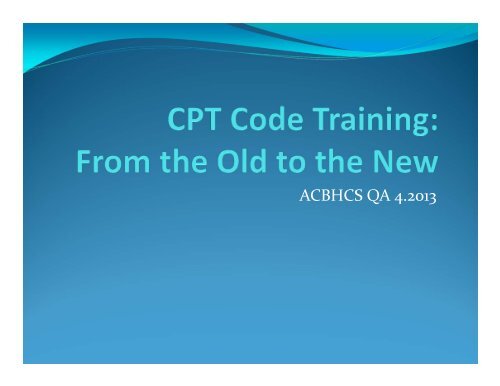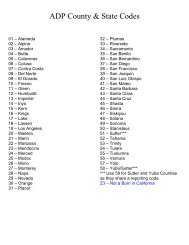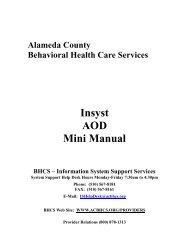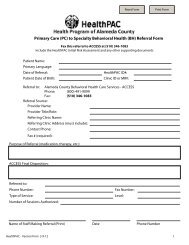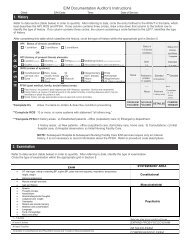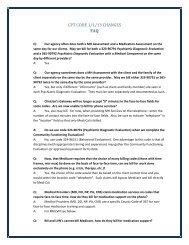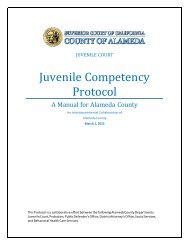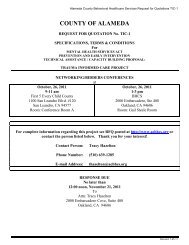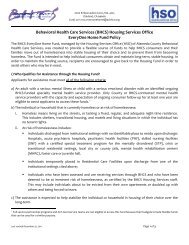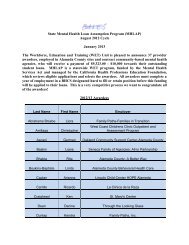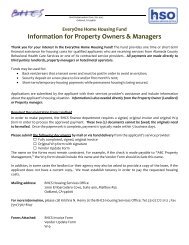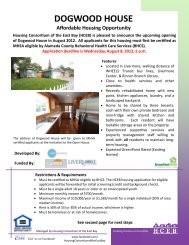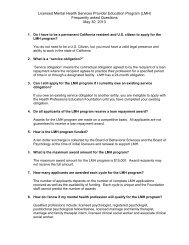ACBHCS QA 4.2013 - Alameda County Behavioral Health
ACBHCS QA 4.2013 - Alameda County Behavioral Health
ACBHCS QA 4.2013 - Alameda County Behavioral Health
Create successful ePaper yourself
Turn your PDF publications into a flip-book with our unique Google optimized e-Paper software.
<strong>ACBHCS</strong> <strong>QA</strong> <strong>4.2013</strong>
Overarching Themes<br />
• Three methods described for documenting codes<br />
(know when an explanation applies to your staff):<br />
• In Clinician’s Gateway—<strong>County</strong> EHR<br />
• In Paper Chart<br />
• In InSyst<br />
• Now documentation is uniform—no longer chart<br />
differently for specific insurance/payor (e.g.. Medi‐Cal vs.<br />
Medicare).<br />
• E/M Codes are specific to Medical Providers:<br />
• Psychiatrists (MD, DO)<br />
• Advance Practice Nurses (APN: NP and CNS)<br />
• Physician Assistants (PA)
AGENDA<br />
• Why we are doing this training<br />
HANDOUTS<br />
• CPT Power Point Presentation<br />
• CPT FAQ<br />
• CPT Code Sheets: Crosswalks & Master<br />
• Guidelines for Scope of Practice<br />
• Handout for CG users<br />
• Interactive Complexity Info Sheet<br />
• E/M Services Guide: Coding by Key Component<br />
• E/M Client Examples: Office, Established client
CPT Codes vs. HCPC vs. Procedure Codes<br />
• 3 Types of Codes:<br />
• InSyst three digit Procedure Codes are used by our providers<br />
for service entry. These procedure codes translate into HCPC or<br />
CPT codes when BHCS bills the service.<br />
• CPT codes are used by Medicare and commercial insurance for<br />
billing.<br />
• HCPC Codes are used by Medi‐Cal for billing (behind the scenes)<br />
• You must use both the 3 digit InSyst (<strong>County</strong>)<br />
Procedure codes and the 5 digit CPT codes in your<br />
documentation.<br />
• If there is not an associated CPT code (such as Rehab Svcs),<br />
just use the 3 digit InSyst code.
New InSyst Procedure codes map to<br />
Medicare CPT and Medi‐Cal<br />
HCPC Codes in the background<br />
• Codes: Initial Eval, Community Functioning<br />
Evaluation, E&M, Psychotherapy, Crisis<br />
Therapy & Add‐on Codes<br />
• INSYST can distinguish if these services are<br />
being billed by LCSW, MFT, intern, etc.<br />
• If an MFT (for a client with Medicare & Medi‐Cal)<br />
bills for psychotherapy, INSYST sees that and sends<br />
it to Medi‐Cal (since an MFT cannot bill Medicare)<br />
• In this case, even though Medicare will not be<br />
billed, we still use the new codes.
Deleted Procedure Codes<br />
Old New New Code Description<br />
90862 E/M N/A Pharmacologic Management<br />
90857 Group Therapy +<br />
Interactive<br />
Complexity add‐on<br />
Multi<br />
ple<br />
Use Non‐AB3632<br />
Codes<br />
456‐90853<br />
+491<br />
N/A<br />
Interactive Group Therapy<br />
AB3632 Codes (except Day Treatment & Day<br />
Rehab)<br />
90805<br />
90807<br />
Use E/M +<br />
Psychotherapy<br />
add‐on codes<br />
E/M +<br />
+441‐90832<br />
+442‐90834<br />
+443‐90837<br />
Combination codes for Medication<br />
Management with Psychotherapy
Retained Procedure Codes<br />
Old New CPT Description<br />
413<br />
449<br />
455<br />
413<br />
449<br />
455<br />
90846,<br />
90847,<br />
90849<br />
Family Psychotherapy without Client Present<br />
Family Psychotherapy with Client Present<br />
Multiple‐family Group Psychotherapy
New or Revised InSyst/CPT Codes<br />
Old New CPT Description<br />
331/332*<br />
433/434<br />
323<br />
565<br />
90791<br />
90792<br />
Psychiatric Diagnostic Evaluation (Initial & Reassessment)<br />
Psych Diag Eval with Medical (Initial & Reassessment)<br />
321/322* 324 96151 Behav. Eval. (Comm. Funct’ng Eval. or Co. Approved Equiv.)<br />
341/342*<br />
444‐8/<br />
4450<br />
463/464<br />
466<br />
441<br />
442<br />
443<br />
+465/7/<br />
8<br />
90832<br />
90834<br />
90837<br />
+90833/6/<br />
8<br />
Psychotherapy: 30 minutes<br />
Psychotherapy: 45 minutes<br />
Psychotherapy: 60 minutes<br />
351/457 456 90853 Group Psychotherapy<br />
Add‐on Psychotherapy (to E/M): 30/45/60 minutes<br />
new +491 +90785 Interactive Complexity Add On (only for select codes)<br />
371/372* 377 90839 Crisis Therapy : 60 minutes (previously Crisis Services)<br />
+378 +90840 Add‐on Crisis Therapy: 30 minute increments<br />
641/3‐6 641/3‐6 99211‐5 E/M Established outpatient Codes: Avg: 5/10/15/25/40 min’s<br />
new 369 ‐‐‐ Meds Management RN/LVN/PT only (f‐f or non f‐f)<br />
new 367 ‐‐‐ Medical Provider Non f‐f Medication Trng & Support<br />
* Eliminated AB3632 Codes.
Psychiatric Diagnostic Evaluation Procedure<br />
Codes: 323—90791, 565‐‐90792<br />
• Two new codes distinguish between:<br />
323‐‐90791: an initial evaluation without medical services includes the following:<br />
• Biopsychosocial assessment including history, mental status and<br />
recommendations and may include:<br />
• communication with family, others, and<br />
• review and ordering of diagnostic studies<br />
565‐‐90792: an initial evaluation with medical activities provided only by a medical<br />
provider includes those services in 90791 and:<br />
• Medical assessment Physical exam beyond mental status (when appropriate)<br />
• May include:<br />
• communication with family, others,<br />
• prescription medications, and<br />
• review and ordering of laboratory or other diagnostic studies
Psychiatric Diagnostic Evaluation Procedure<br />
Codes: 323—90791, 565—90792 Cont.<br />
• Reporting Psychiatric Diagnostic Procedures<br />
• Each Psychiatric Diagnostic Codes may be reported only once per day<br />
(unless seeing the client and significant other separately).<br />
• 323‐90791 Psych Diag Eval may be provided by a non‐medical provider<br />
on the same day 565‐90792 Psych Diag Eval with Medical Component<br />
is provided by a medical provider (psychiatrist/ANP/PA).<br />
• Cannot be reported with an E/M code on same day by same individual<br />
provider.<br />
• Cannot be reported with psychotherapy service code on same day by<br />
any provider.<br />
• May be reported more than once for a client when separate diagnostic<br />
evaluations are conducted with the client and other collaterals (such as<br />
family members, guardians, and significant others).<br />
1. Diagnostic evaluation for child with child.<br />
2. Diagnostic evaluation for child with caretaker.<br />
• Use the same codes, for later reassessment, as indicated.
Non E/M Codes (Psychotherapy & Crisis):<br />
Time Periods & (+) Add‐ On Codes<br />
• Choose the procedure code based on the f‐f<br />
time spent in session (or contact time on<br />
phone—indicate phone in location field)<br />
• Supporting Documentation & Travel Time will<br />
be included in Total Time<br />
• “Add‐on+”, a new code for additional time spent<br />
in session (Crisis Therapy only)<br />
• “Add‐on+”, a code based on Intensity of Service<br />
Provided (Interactive Complexity) for Diag<br />
Eval, Ind & Group Psychotherapy (per<br />
individual) & E/M with + add‐on<br />
Psychotherapy)
Choosing the non E/M Codes (Psychotherapy &<br />
Crisis): Based on F‐F Time Spent in Session<br />
• “A unit of time is attained when the mid‐point of the time<br />
period is passed.” CPT Manual 2013<br />
• Always choose code on exact number of f‐f minutes<br />
(for non f‐f use, telephone, use client contact<br />
minutes—and indicate phone in location field.).<br />
Procedure<br />
Code:<br />
Therapy<br />
CPT<br />
Code<br />
Typical Time Period<br />
(minutes)<br />
Actual/F‐F Time<br />
(minutes)<br />
441 90832 30” Psychotherapy 16‐37”<br />
442 90834 45” Psychotherapy 38‐52”<br />
443 90837 60” Psychotherapy 53”‐beyond<br />
377 90839 60” Crisis Therapy 30‐75”<br />
+ 378 + 90840 Each Additional 16 – 45”<br />
Crisis Therapy<br />
16‐45”
Time Spent in Session: examples<br />
1. 441‐90832 Psychotherapy 16‐37”:<br />
Actual F‐F is 34 minutes.<br />
2. 442‐90834 Psychotherapy 38‐52”:<br />
Actual F‐F is 40 minutes.<br />
[ 441 34 ][ 40 442 ][ 443<br />
[16 (30) 37] [38 (45) 52][53
Claiming Face‐to‐Face Time and Total<br />
Time: Clinician’s Gateway<br />
Psychotherapy: 36” f‐f time, 10” doc. time,<br />
and 20” travel time. Total time = 66”.<br />
(1:06)<br />
• Choose code based on f‐f time (or contact time<br />
for telephone) and enter that amount of time for<br />
that code:<br />
• 441‐90832 (Ind Psych 16‐37 min.) enter:<br />
36” in “Primary F‐F Time”<br />
• Total time. Enter:<br />
66” (1:06) in: “Primary Clinician Time”<br />
Warning: To choose code based on total time<br />
would be considered Fraudulent by Medicare.
PSYCHOTHERAPY FACE TO FACE TIME = 36” (:36)<br />
DOC/TRAVEL TIME = 30” (:30) TOTAL TIME = 66” (1:06)
Claiming Face‐to‐Face Time and Total<br />
Time: InSyst Direct Entry<br />
Psychotherapy: 45” f‐f time, 10” doc. time,<br />
and 20” travel time. Total time = 75”.<br />
• Choose code based on f‐f time (if on the<br />
phone—base on contact time):<br />
• 442‐90834 (Ind Psych 38‐52 min.)<br />
• Enter Total Time:<br />
• 75”<br />
• Warning: To choose code based on total time<br />
would be considered Fraudulent by Medicare.
Add‐On Codes (+)<br />
Add‐On (+) codes describe additional services provided<br />
within a service. They are added to select, primary codes<br />
and demonstrate an enhanced service.<br />
• Added time increments (crisis therapy)<br />
• Added service (interactive complexity or<br />
psychotherapy)<br />
• Add‐on (+) codes are never used as stand alone codes<br />
• Add‐on codes are designated by a + sign<br />
Note: In addition to Medicare, other Private Insurance Carriers may<br />
use these codes. Therefore, ALL clinicians need to code according to<br />
the service they are providing, not to the insurance of the client.
Add‐On Codes continued:<br />
•Additional Time Spent: for Crisis<br />
Therapy—concept in general.<br />
• 377‐90839 is used for the first 30‐75”<br />
• 378‐90840 is used for each additional 16‐45”<br />
• For charting and CG: when you go beyond a 377 and use<br />
a 378‐‐the 377 is indicated as 60” and the balance moves<br />
down to 378.<br />
• If an additional 378 is needed the earlier 378 indicates<br />
30” and the balance moves down to the next 378.<br />
• The final 378 includes the actual remaining minutes of<br />
f‐f time.
Crisis Code 377‐90839 (Used Alone)<br />
• InSyst<br />
• Crisis service lasting 45” f‐f, 15” doc/travel<br />
• Based on f‐f time choose code 377‐90839 (30‐75”)<br />
• Enter 60” (45” f‐f + 15” doc/travel)<br />
• Clinician’s Gateway<br />
• Crisis service lasting 45” f‐f, 15” doc/travel<br />
• Use code 377‐90839 for the 45” f‐f time.<br />
• Enter 45” into “Primary f‐f Time”<br />
• Enter Total Time of 60” (1:00) (45” f‐f + 15” doc/travel) into<br />
“Primary Clinician Time”<br />
• See screen shot<br />
• For < 30 minutes can not use Crisis Code (if appropriate use and<br />
chart to a different code, e.g. individual psychotherapy, E/M, etc.)
CRISIS THERAPY FACE TO FACE TIME = 45” (:45)<br />
DOC/TRAVEL TIME = 15” (:15) TOTAL TIME = 60” (1:00)
Crisis Code 377‐90839 + 378‐90840<br />
• InSyst<br />
• Crisis service: 115” F‐F Time + 60” Travel/Doc Time = 175” Total Time<br />
• Select Code 377‐90839 for the 1st 60” = 60” duration time<br />
• Select Code 378‐90840 for next 30” = 30” duration time<br />
• Select Code 378‐90840 for the add’l 25” = 85” duration time<br />
• Includes 25” F‐F time + 60” Travel/Doc time<br />
• In paper chart, indicate:<br />
• “377‐90839, +378‐90840, +378‐90840. F‐F = 115”, Total Time = 175”<br />
• OK to also indicate documentation and travel time.<br />
• Clinician’s Gateway:<br />
• Crisis service: 115” (1:55) F‐F Time + 60” (1:00) Travel/Doc Time = 175” (2:55) Total<br />
Time<br />
• Select code 377‐90839 and enter 60” (1:00) in “Primary FF Time” & 60” (1:00) into<br />
“Primary Clinician Time”<br />
• Select code 378‐90840 and enter= 55 “in “Secondary FF Time” & 115 (1:55) into<br />
“Secondary Total Time” (55” remaining f‐f + 60” doc/travel time).<br />
• See Screen Shot
CRISIS THERAPY FACE TO FACE TIME = 115” (1:55)<br />
DOC/TRAVEL TIME = 60” (1:00) TOTAL TIME = 175” (2:55)
Add‐On Code for Additional Service Provided:<br />
Interactive Complexity<br />
Refers to specific communication factors during a visit<br />
that complicate delivery of the primary psychiatric<br />
procedure:<br />
• Typical clients:<br />
• Have others legally responsible for their care, such<br />
as minors or adults with guardians<br />
• Request others to be involved in their care during<br />
the visit<br />
• Require the involvement of other third parties,<br />
such as child welfare agencies, parole or probation<br />
officers, or schools
Add‐On Code for Additional Service Provided:<br />
Interactive Complexity (491‐90785) cont.<br />
4 specific communication factors during a visit that<br />
complicate delivery of the primary psychiatric procedure:<br />
1. The need to manage maladaptive communication (related to<br />
e.g., high anxiety, high reactivity, repeated questions, or<br />
disagreement) among participants that complicates delivery of<br />
care.<br />
• Vignette (reported with 442‐90834, Psychotherapy 45 min)<br />
• Psychotherapy for an older elementary school‐aged child accompanied<br />
by divorced parents, reporting declining grades, temper outbursts, and<br />
bedtime difficulties. Parents are extremely anxious and repeatedly ask<br />
questions about the treatment process. Each parent continually<br />
challenges the other’s observations of the client.
Add‐On Code for Additional Service Provided:<br />
Interactive Complexity (491‐90785) cont.<br />
4 specific communication factors during a visit that<br />
complicate delivery of the primary psychiatric<br />
procedure:<br />
2. Caregiver emotions or behaviors that interfere with<br />
implementation of the treatment plan<br />
• Vignette (reported with 441‐90832, psychotherapy 30 min)<br />
• Psychotherapy for young elementary school‐aged child. During the<br />
parent portion of the visit, mother has difficulty refocusing from<br />
verbalizing her own job stress to grasp the recommended behavioral<br />
interventions for her child.
Add‐On Code for Additional Service Provided:<br />
Interactive Complexity (491‐90785) cont.<br />
4 specific communication factors during a visit that<br />
complicate delivery of the primary psychiatric<br />
procedure:<br />
3. Evidence or disclosure of a Sentinel Event and mandated<br />
reporting to a 3 rd party (e.g., abuse or neglect with report<br />
to state agency) with initiation of discussion of the<br />
sentinel event and/or report with client and other visit<br />
participants<br />
• Vignette (reported with 565‐90792, psychiatric diagnostic evaluation<br />
with medical services)<br />
• In the process of an evaluation, adolescent reports several episodes<br />
of sexual molestation by her older brother. The allegations are<br />
discussed with parents and report is made to state agency.
Add‐On Code for Additional Service Provided:<br />
Interactive Complexity (491‐90785) cont.<br />
4 specific communication factors during a visit that<br />
complicate delivery of the primary psychiatric procedure:<br />
4. Use of play equipment, physical devices, interpreter or<br />
translator** to overcome barriers to diagnostic or therapeutic<br />
interaction with a client who is not fluent in the same language<br />
or who has not developed or lost expressive or receptive<br />
language skills to use or understand typical language.<br />
• Vignette (reported with 456‐90853, group psychotherapy)<br />
• Group psychotherapy for a young child who requires play<br />
equipment to participate in the group therapeutic interaction<br />
**Per CMS, 491 should not be used to bill solely for translation<br />
or interpretation services as that may be a violation of federal<br />
statute.
Add‐On (+) Procedure Code for<br />
Interactive Complexity (+491‐90785)<br />
Can only be used with these codes:<br />
• 323‐90791 & 565‐90792 Psychiatric Diagnostic Eval.<br />
• 441‐90832, 442‐90834, 443‐90837 Psychotherapy<br />
• E/M+465‐90833, E/M+467‐90836, E/M+468‐90838 E/M<br />
with + Psychotherapy add‐on<br />
• 456‐90853 Group Psychotherapy<br />
Cannot be used with Crisis Therapy, Family<br />
Therapy, or with other E/M codes when no<br />
psychotherapy was provided.
Interactive Complexity (+) 491‐<br />
90785 Add‐on in InSyst & CG<br />
• Select primary procedure code and indicate minutes (into<br />
InSyst or Clinician’s Gateway) as previously described.<br />
• Select Interactive Complexity Add‐on Code (no associated<br />
minutes).<br />
• InSyst, Select code 491‐90785 and enter one (1) minute<br />
• Clinician’s Gateway, Select “Interactive Complexity: Present”
Interactive Complexity 491‐90785 Add‐on (+) in<br />
Clinician’s Gateway (CG) EHR
Psychotherapy Add‐on Codes to E/M<br />
• Must be added on to an E/M code.<br />
• Cannot bill for < 16 min Psychotherapy Add‐on<br />
• For Medical Providers only (MD, DO, CNS, NP, PA)<br />
• + 441 + 90832 = Psychotherapy Additional 16‐37”<br />
• + 442 + 90834 = Psychotherapy Additional 38‐52”<br />
• + 443 + 90837 = Psychotherapy Additional 53” +
Documenting Add‐On (+) Codes<br />
• Medicare/CMS requires that each add‐on<br />
code is indicated in the chart note.<br />
• Example:<br />
• 377‐90839 Crisis Therapy<br />
• +378‐90840 Crisis Therapy add‐on<br />
• +378‐90840 Crisis Therapy add‐on<br />
• When documenting for an add‐on code, be<br />
sure that the note content reflects the<br />
service and/or time frame of the add‐on.
Evaluation and Management (E/M)<br />
Codes: 99###<br />
• Psychiatric services now may be reported with the same range of<br />
complexity and physician work as has long been available to all<br />
other medical specialties<br />
• Code starts with “99” and comprised of 5 digits<br />
• Used to report a medical service rendered during a client visit<br />
• The level of service is indicated by the last digit.<br />
• Level 1 is the least complex<br />
• Level 5 is greater complexity (outpatient) or Level 3 (inpt)<br />
• Used by all physicians and (MD, DO) and other qualified health<br />
care professionals (APN, PA)<br />
• In addition, E/M codes typically pay more for the same service
Medicare Payments<br />
Code Payment Difference % Increase<br />
90862 $58.54 (prev. 30”) Baseline Baseline<br />
99211 $19.74 (1‐7”)<br />
99212 $42.55 (8‐12”)<br />
99213 $70.46 (13‐20”) Additional $11.92 20% Increase<br />
99214 $104.16 (21‐32”) Additional $45.62 78% Increase<br />
99215 $139.89 (33”+)
CPT E/M New client Definition—CBO’s Only<br />
• 545‐549/99201‐99205. A new client is one who has not<br />
received any professional services from<br />
• the medical provider or another medical provider of the<br />
same specialty or sub‐specialty<br />
• who belongs to the same group practice (same Tax<br />
ID Number (TIN)<br />
• within the past three years.<br />
• Each <strong>ACBHCS</strong> Contracted Community Based<br />
Organization (all sites) is it’s own group practice.<br />
• New client Codes ONLY FOR CBO PROVIDERS—<br />
<strong>County</strong> Medical Providers use 565—90792<br />
Psychiatric Diagnostic Evaluation with<br />
Medical Component
CPT E/M Established client Definition<br />
• 641,643‐6/99211—99215. An established client is one who<br />
has received professional services from<br />
• the medical provider or another medical provider of the<br />
same specialty or sub‐speciality*<br />
• who belongs to the same group practice (same TIN),<br />
• Either a specific CBO, or<br />
• any of the <strong>ACBHCS</strong> <strong>County</strong> Owned & Operated Clinics<br />
• within the past 3 years<br />
*Psychiatric subspecialty's include: Child & Adolescent, Geriatric,<br />
Addiction, Forensic & Psychosomatic Medicine.
Two Paths to E/M Selection<br />
• PATH ONE<br />
• Basing the code on Time<br />
• Counseling and Coordination<br />
of Care are 50% or > of f‐f time.<br />
• The only exception to this if<br />
you are using an add on<br />
psychotherapy code, you<br />
cannot use time as the basis of<br />
selecting the code for the E/M<br />
portion of the work.<br />
• In the Community MH<br />
setting it is often found that<br />
the majority of E/M services<br />
include Counseling &<br />
Coordination of Care which<br />
is over 50% of f‐f time.<br />
• PATH TWO<br />
• Basing the code on the<br />
Elements<br />
• History<br />
• Exam<br />
• Medical Decision Making
Path 1: Choosing the E/M Code Based on Time:<br />
Counseling & Coordination of Care<br />
• Time shall be the key controlling factor used for<br />
the selection of the Level of the E/M Service<br />
• when counseling or coordination of care dominates the<br />
encounter more than 50 percent<br />
• Face‐to‐face time for office visits<br />
• Unit time for facility visits<br />
• EXCEPT time cannot be the factor for selection of the<br />
level when done in conjunction with a psychotherapy<br />
visit.
Path 1: Choosing the E/M Code Based on<br />
Time: Counseling & Coord. of Care cont.<br />
• Document:<br />
• Length of time of the encounter and of the<br />
time spent in counseling and coordination of<br />
care.<br />
• AND the content of the counseling<br />
and/or coordination of care activities
Path 1: Choosing the E/M Code Based on<br />
Time: Counseling & Coord. of Care cont.<br />
• > 50% of the Time is Spent Discussing with the<br />
client, or Family, Any of the Following<br />
(Counseling):<br />
• Prognosis<br />
• Test Results<br />
• Compliance/Adherence<br />
• Education<br />
• Risk Reduction<br />
• Instructions<br />
• The time & counseling activities must be<br />
thoroughly documented.
Path 1: Choosing the E/M Code Based on<br />
Time: Counseling & Coord. of Care cont.<br />
• Codes & Timeframes<br />
NEW client VISIT TIME—CBO’s ESTABLISHED client VISIT TIME<br />
CODE MINUTES CODE MINUTES<br />
/<br />
545‐99201 10 (6 – 15”) 641‐99211 5 (3 – 7”)<br />
546‐99202 20 (16 – 25”) 643‐99212 10 (8 – 12”)<br />
547‐99203 30 (26 – 37”) 644‐99213 15 (13 – 20”)<br />
548‐99204 45 (38 – 52”) 645‐99214 25 (21 – 32”)<br />
549‐99205 60 (53” + ) 646‐99215 40 (33” +)
Path 1: Choosing the E/M Code Based on<br />
Time: Counseling & Coord. of Care cont.<br />
• Counseling: Discussion with a client or the client’s<br />
family concerning one or more of the following issues:<br />
• Diagnostic results, Prior studies, Need for further testing<br />
• Impressions<br />
• Clinical course, Prognosis<br />
• Treatment options, Medication Issues, Risks and benefits of<br />
management options<br />
• Instructions for management and/or follow‐up<br />
• Importance of compliance with chosen management options<br />
• Risk factor reduction<br />
• Client education
Path 1: Choosing the E/M Code Based on<br />
Time: Counseling & Coord. of Care cont.<br />
• Although CPT considers “counseling” as separate and distinct<br />
from psychotherapy, psychiatrists typically include counseling<br />
(as defined by CPT) as part of their regular treatment.<br />
• Many of the components of “Supportive Psychotherapy” may be<br />
considered as overlapping with “Counseling” (as defined by<br />
CPT).<br />
• “From the clinician’s objectives—to maintain or improve the client’s<br />
self‐esteem, to minimize or prevent recurrence of symptoms, and to<br />
maximize the client’s adaptive capacities.”*<br />
• “From the client’s goals—to maintain or reestablish the best‐possible<br />
level of functioning given the limitations of his or her personality,<br />
native ability, and life circumstances…”*<br />
*An Introduction to Supportive Psychotherapy published by the American<br />
Psychiatry Press, Inc.
Path 1: Choosing the E/M Code Based on<br />
Time: Counseling & Coord. of Care cont.<br />
CPT Elements of Counseling<br />
Diagnostic results, impressions, and/or<br />
recommended diagnostic studies<br />
Prognosis<br />
Risks and benefits of management<br />
(treatment) options<br />
Instructions for management (treatment)<br />
and/or follow‐up<br />
Importance of compliance with chosen<br />
management (treatment) options<br />
Risk factor reduction<br />
Corresponding Elements of Supportive<br />
Psychotherapy*<br />
Advice and Teaching<br />
Reassurance & Encouragement<br />
Advice and Teaching,<br />
Rationalizing and Reframing<br />
Anticipatory Guidance,<br />
Reducing and Preventing Anxiety<br />
Naming the Problem<br />
Advice and Teaching<br />
Expanding the client’s Awareness<br />
Naming the Problem<br />
Expanding the Client’s Awareness<br />
Advice and Teaching<br />
*Introduction to Supportive Psychotherapy, Amer. Psych. Press, Inc. 2004
Path 1: Choosing the E/M Code Based on<br />
Time: Counseling & Coord. of Care cont.<br />
• Coordination of care:<br />
• Services provided by the medical provider responsible<br />
for the direct care of a client when he or she<br />
coordinates or controls access to care or initiates or<br />
supervises other healthcare services needed by the<br />
client.<br />
• outpatient coordination of care must be provided<br />
face‐to‐face with the client.<br />
• Coordination of care with other providers or agencies<br />
without the client being present on that day is reported<br />
with the non face‐face code 367.
outpatient/OFFICE PSYCHIATRIC PROGRESS NOTE<br />
COUNSELING AND/OR COORDINATION OF CARE<br />
client’s Name: _________________________________________________________Date of Visit:______________________<br />
Interval History:__________________________________________________________________________________________<br />
________________________________________________________________________________________________________<br />
________________________________________________________________________________________________________<br />
________________________________________________________________________________________________________<br />
Interval Psychiatric Assessment/ Mental Status Examination:<br />
________________________________________________________________________________________________________<br />
________________________________________________________________________________________________________<br />
________________________________________________________________________________________________________<br />
Current Diagnosis:_________________________________________________________________________________________<br />
Diagnosis Update:_________________________________________________________________________________________<br />
Current Medication(s)/Medication Change(s) – No side effects or adverse reactions noted or reported<br />
________________________________________________________________________________________________________<br />
________________________________________________________________________________________________________<br />
Lab Tests: Ordered Reviewed : ______________________________________________________________________________<br />
________________________________________________________________________________________________________<br />
Counseling Provided with client / Family / Caregiver (circle as appropriate and circle each counseling topic<br />
Discussed and describe below:<br />
Diagnostic results/impressions and/or recommended studies Risks and benefits of treatment options<br />
Instruction for management/treatment and/or follow‐up Importance of compliance with chosen treatment options<br />
Risk Factor Reduction client/Family/Caregiver Education Prognosis<br />
_________________________________________________________________________________________________________<br />
_________________________________________________________________________________________________________<br />
_________________________________________________________________________________________________________<br />
_________________________________________________________________________________________________________<br />
_________________________________________________________________________________________________________<br />
_________________________________________________________________________________________________________<br />
Coordination of care provided (with client present) with (circle all appropriate and describe below):<br />
Coordination with: Nursing Residential Staff Social Work Physician/s Family Caregiver<br />
_________________________________________________________________________________________________________<br />
_________________________________________________________________________________________________________<br />
_________________________________________________________________________________________________________<br />
Additional Documentation (if needed):_________________________________________________________________________<br />
_________________________________________________________________________________________________________<br />
_________________________________________________________________________________________________________<br />
Duration of face to face visit w/client:_______min. Start Time _________ Stop Time_________ CPT Code_________________<br />
Greater than 50% of face to face time spent providing counseling and/or coordination of care:<br />
Psychiatrist’s Signature:_____________________________________Date:____________________________________________
See hand‐outs<br />
Progress Note Templates for:<br />
E/M Notes Based on Counseling & Coordination of Care:<br />
Inpt & Outp
Example of Counseling &<br />
Coordination of Care—Outpt.<br />
• A client returns to a psychiatrist’s office for a medication check.<br />
• The encounter takes a total of 25 minutes, during which time<br />
more than 12.5 minutes is spent explaining to the client about<br />
how a newly prescribed medication works, how to establish a<br />
routine so that no doses will be missed, and the possible sideeffects<br />
of the medication and what to do if they occur.<br />
• The appropriate E/M code would be 645‐99214 (office or<br />
outpatient service for an established client), based on the 25‐<br />
minute time rather than on a detailed history and examination<br />
and moderately complex medical decision making that would be<br />
required to use this code if counseling and coordination had not<br />
taken up more than 50 percent of the time.<br />
• The psychiatrist documents the extent of the<br />
counseling/coordination of care in the daily progress note.
Medical Necessity—CMS<br />
• The Center for Medicare and Medicaid (CMS) defines<br />
medically necessary services as those that are<br />
• “reasonable and necessary for the diagnosis or treatment<br />
of illness or injury or to improve the functioning of a<br />
malformed body member”<br />
• In short, services must be clinically appropriate for the<br />
client’s condition
General Principles of<br />
Documentation<br />
• Complete and legible<br />
• Include:<br />
• Reason for the encounter and relevant history, physical<br />
examination findings and prior diagnostic test results<br />
• Assessment, clinical impression or diagnosis<br />
• Plan for care<br />
• Date and legible identity of the observer<br />
• Over
General Principles of<br />
Documentation cont.<br />
• Rationale for ordering ancillary services should be<br />
easily inferred<br />
• Past and present diagnoses should be accessible<br />
• Appropriate health risk factors should be identified<br />
• Document the client's response to, changes in<br />
treatment, and revision of diagnosis<br />
• The CPT and ICD‐9‐CM codes reported should be<br />
supported.
General Audit Issues<br />
• Upcoding<br />
• Downcoding<br />
• Meet E/M criteria<br />
• Medical necessity<br />
• Red flags<br />
• High use of highest level code<br />
• Exclusive use of one level code
Path 1: Choosing the E/M Code Based<br />
on Time: Counseling & Coord. of Care<br />
• CMS: Most Frequently Missed Items in E/M<br />
Documentation:<br />
• Time Based Codes<br />
• In choosing a code based upon time for counseling<br />
and coordination of care, total time may be<br />
documented but there is not:<br />
• quantification that more than 50 percent of the time<br />
was spent on counseling and there is also<br />
• no documentation of what the coordination of care<br />
was or what the counseling was.
Path 1: Choosing the E/M Code Based on<br />
Time: Counseling & Coordination of Care<br />
AUDITOR’S WORKSHEET Yes No<br />
Does documentation reveal total time (Face‐to‐face in<br />
outpatient setting; unit/floor in inpatient setting) and<br />
indicate > 50% of the total time was counseling and<br />
coordination of care services?<br />
Does documentation describe the content of counseling or<br />
coordinating care?<br />
Does documentation support that more than half of the total<br />
time was counseling or coordinating of care?<br />
Note. If all answers are yes, select level based on time.
Path 2: Choosing the E/M Code<br />
Based on the Elements<br />
• History<br />
• Exam<br />
• Medical<br />
Decision<br />
Making<br />
‐ Chief Complaint<br />
‐ History of Present Illness (HPI)<br />
‐ Past, Family and/or Social History (PFSH)<br />
‐ Review of Systems (ROS)<br />
‐ Number of system/body areas examined<br />
‐ “Bullets” or elements completed within specific<br />
systems<br />
‐ Number of Diagnoses or Management Options<br />
‐ Amount and/or Complexity of Data to be Reviewed<br />
‐ Risk of Significant Complications, Morbidity,<br />
and/or Mortality<br />
Each line impacts kind of History, Exam, and MDM
Path 2: Choosing the E/M Code Based on the Elements: Knowing your client try<br />
to think ahead of the level of E/M you will be providing.<br />
Established Patient<br />
Office<br />
Visit<br />
(Requires 2of 3)<br />
CPT Code History Exam MDM<br />
99211 N/A N/A N/A<br />
99212 PF PF Straightforward<br />
99213 EPF EPF LOW<br />
99214 DET DET Moderate<br />
99215 COMP COMP High
Path 2: Choosing the E/M Code Based on the Elements: Knowing your client try<br />
to think ahead of the level of E/M you will be providing cont.<br />
• 645‐99214: E/M Established Outpatient Moderate Complexity<br />
(Requires 2 of 3):<br />
• History<br />
(detailed)<br />
• Exam<br />
(detailed)<br />
• Medical<br />
Decision<br />
Making<br />
(moderate—<br />
must meet 2<br />
Of 3.)<br />
‐ Chief Complaint‐‐required<br />
‐ History of Present Illness (HPI)—4 elements<br />
OR 3 chronic conditions.<br />
‐ Past, Family and/or Social History (PFSH)—1 element<br />
‐ Review of Systems (ROS)—2 systems<br />
‐ Number of system/body areas examined—9 bullets<br />
‐ Specific “Bullets” or elements completed within specific<br />
systems required for Comprehensive.<br />
‐ Number of Diagnoses or Management Options—3 points<br />
‐ Amount and/or Complexity of Data to be Reviewed—3 points<br />
‐ Risk of Significant Complications, Morbidity,<br />
and/or Mortality—Moderate Risk
The Codes and Documentation Requirements—<br />
Established client E/M cont.<br />
See E/M Svcs Guide: Coding by Key Component.
See E/M Progress Note Template Based on the Elements<br />
And Associated Audit Tool.
Path 2: Choosing the E/M Code<br />
Based on the Elements cont.<br />
• Medical Providers should train by reading the CPT<br />
Manual (see additional training resources at<br />
conclusion of presentation) and by attending trainings<br />
such as these webinars (see packet for Power Point):<br />
• http://www.aacap.org/cs/business_of_practice/reimbur<br />
sement_for_practitioners<br />
• http://www.apaeducation.org/ihtml/application/studen<br />
t/interface.apa/index.htm
Medication Support: RN/LVN/Psych<br />
Tech only (Not an add‐on)<br />
369 Meds Management by<br />
RN/LVN/Psych Tech’s Only<br />
This procedure code was developed for RN’s and LVN’s<br />
who provide medication management but who can not<br />
bill Medicare. Medi‐Cal billable only.<br />
• This code should be used when doing medication<br />
injections and providing medication support<br />
• Face‐to‐Face and Non Face‐to‐Face<br />
• The expectation is that time spent would be 15‐30<br />
minutes. If service is provided beyond 30 minutes, the<br />
documentation must support that level of service.
Medication Support: Medical<br />
Providers (MD, DO, NP, PA, CNS)<br />
(Not an add‐on)<br />
• This procedure code was developed for non face‐toface,<br />
and therefore non billable to Medicare,<br />
Medication Services<br />
• 367—Medication Training and Support<br />
• Used ONLY for Non face‐to‐face services
Elimination of AB3632<br />
procedure codes<br />
• Most AB 3632 procedure codes—except for Day<br />
Rehab & Day Tx—have been eliminated<br />
beginning with January 2013 dates of service.<br />
• AB 3632/ERHMS now uses the same codes as<br />
everyone else—except for Day Rehab & Day Tx.<br />
• All children in the ERMHS program must be<br />
identified in the ERMHS database maintained by<br />
BHCS Children’s Specialized Services.
Contact Us:<br />
• For questions on coding, please contact Quality<br />
Assurance at (510)567‐ 8105<br />
• If you feel that you are missing a procedure code<br />
that you are contracted for, that should be<br />
included in your RU, please call Provider Relations<br />
at (800) 878‐1313.<br />
• For Clinicians Gateway questions, Please contact<br />
IS at (510)567‐8181.<br />
• For questions regarding your agency contract,<br />
please contact the Network Office at (510) 567‐8296
Training Resources:<br />
The National Council Resource Page:<br />
• http://www.thenationalcouncil.org/cs/cpt_codes<br />
The APA Resource Page<br />
• http://www.psych.org/practice/managing‐a‐practice/cpt‐changes‐<br />
2013/current‐procedural‐terminology‐cpt‐code‐changes‐for‐2013<br />
The AMA<br />
• http://www.ama‐assn.org/ama/pub/physician‐resources/solutionsmanaging‐your‐practice/coding‐billing‐insurance/cpt.page?<br />
• The AMA app: EM Quickref (android or apple)<br />
• AMA Webinar ‐ Psychotherapy/Psychiatric Services: CPT ® 2013 Changes<br />
‐ Psychotherapy/Psychiatric Services. This one‐hour program discusses<br />
the changes made in the Psychotherapy/Psychiatric Services coding section.
Resources:<br />
• CPT Handbook for Psychiatrists, American Psychiatric<br />
Press Inc., Third Edition, 2004<br />
• American Psychiatric Association: http://www.psych.org<br />
• American Academy of Child & Adolescent Psychiatrists:<br />
www.aacap.org<br />
• 1997 Documentation Guidelines for Evaluation and<br />
Management Services http://www.cms.gov/Outreach‐and‐<br />
Education/Medicare‐Learning‐Network‐<br />
MLN/MLNEdWebGuide/Downloads/97Docguidelines.pdf<br />
• Center for Medicare and Medicaid Services (CMS)<br />
http://www.cms.gov/Medicare/Medicare.html?redirect=/h<br />
ome/medicare.asp
Resources continued:<br />
• AMA Code Book www.amabookstore.com or 1‐800‐<br />
621‐8335<br />
• National Council webpage dedicated to the CPT<br />
changes with resources such as:<br />
• 2012‐2013 Crosswalk<br />
• Frequently Asked Questions<br />
• Free training resources<br />
• Compliance Watch, new CPT series<br />
• www.TheNationalCouncil.org/CS/Compliance_Watch_<br />
Newsletter


